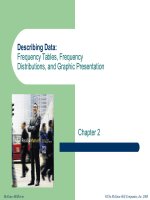Stastical technologies in business economics chapter 14
Bạn đang xem bản rút gọn của tài liệu. Xem và tải ngay bản đầy đủ của tài liệu tại đây (1.74 MB, 63 trang )
Multiple Linear Regression and
Correlation Analysis
Chapter 14
McGraw-Hill/Irwin
©The McGraw-Hill Companies, Inc. 2008
GOALS
2
Describe the relationship between several independent variables and
a dependent variable using multiple regression analysis.
Set up, interpret, and apply an ANOVA table
Compute and interpret the multiple standard error of estimate, the
coefficient of multiple determination, and the adjusted coefficient of
multiple determination.
Conduct a test of hypothesis to determine whether regression
coefficients differ from zero.
Conduct a test of hypothesis on each of the regression coefficients.
Use residual analysis to evaluate the assumptions of multiple
regression analysis.
Evaluate the effects of correlated independent variables.
Use and understand qualitative independent variables.
Understand and interpret the stepwise regression method.
Understand and interpret possible interaction among independent
variables.
Multiple Regression Analysis
The general multiple regression with k
independent variables is given by:
The least squares criterion is used to develop
this equation. Because determining b1, b2, etc. is
very tedious, a software package such as Excel
or MINITAB is recommended.
3
Multiple Regression Analysis
For two independent variables, the general form
of the multiple regression equation is:
•X1 and X2 are the independent variables.
•a is the Y-intercept
•b1 is the net change in Y for each unit change in X1 holding X2
constant. It is called a partial regression coefficient, a net regression
coefficient, or just a regression coefficient.
4
Regression Plane for a 2-Independent
Variable Linear Regression Equation
5
Multiple Linear Regression - Example
Salsberry Realty sells homes along the east
coast of the United States. One of the
questions most frequently asked by
prospective buyers is: If we purchase this
home, how much can we expect to pay to
heat it during the winter? The research
department at Salsberry has been asked to
develop some guidelines regarding heating
costs for single-family homes.
Three variables are thought to relate to the
heating costs: (1) the mean daily outside
temperature, (2) the number of inches of
insulation in the attic, and (3) the age in
years of the furnace.
To investigate, Salsberry’s research department
selected a random sample of 20 recently sold
homes. It determined the cost to heat each
home last January, as well
6
Multiple Linear Regression - Example
7
Multiple Linear Regression – Minitab
Example
8
Multiple Linear Regression – Excel
Example
9
The Multiple Regression Equation –
Interpreting the Regression Coefficients
The regression coefficient for mean outside temperature is 4.583. The coefficient is
negative and shows an inverse relationship between heating cost and temperature.
As the outside temperature increases, the cost to heat the home decreases. The
numeric value of the regression coefficient provides more information. If we
increase temperature by 1 degree and hold the other two independent variables
constant, we can estimate a decrease of $4.583 in monthly heating cost. So if the
mean temperature in Boston is 25 degrees and it is 35 degrees in Philadelphia, all
other things being the same (insulation and age of furnace), we expect the heating
cost would be $45.83 less in Philadelphia.
The attic insulation variable also shows an inverse relationship: the more insulation in
the attic, the less the cost to heat the home. So the negative sign for this coefficient
is logical. For each additional inch of insulation, we expect the cost to heat the
home to decline $14.83 per month, regardless of the outside temperature or the
age of the furnace.
The age of the furnace variable shows a direct relationship. With an older furnace, the
cost to heat the home increases. Specifically, for each additional year older the
furnace is, we expect the cost to increase $6.10 per month.
1
Applying the Model for Estimation
What is the estimated heating cost for a home if the
mean outside temperature is 30 degrees, there
are 5 inches of insulation in the attic, and the
furnace is 10 years old?
1
Multiple Standard Error of Estimate
The multiple standard error of estimate is a measure of the
effectiveness of the regression equation.
It is measured in the same units as the dependent
variable.
It is difficult to determine what is a large value and what
is a small value of the standard error.
The formula is:
1
1
Multiple Regression and
Correlation Assumptions
1
The independent variables and the dependent
variable have a linear relationship. The dependent
variable must be continuous and at least intervalscale.
The residual must be the same for all values of Y.
When this is the case, we say the difference exhibits
homoscedasticity.
The residuals should follow the normal distributed
with mean 0.
Successive values of the dependent variable must
be uncorrelated.
The ANOVA Table
The ANOVA table reports the variation in the
dependent variable. The variation is divided
into two components.
The Explained Variation is that accounted for
by the set of independent variable.
The Unexplained or Random Variation is not
accounted for by the independent variables.
1
Minitab – the ANOVA Table
1
Coefficient of Multiple Determination (r2)
Characteristics of the coefficient of multiple determination:
1. It is symbolized by a capital R squared. In other words, it is written
as because it behaves like the square of a correlation coefficient.
2. It can range from 0 to 1. A value near 0 indicates little association
between the set of independent variables and the dependent
variable. A value near 1 means a strong association.
3. It cannot assume negative values. Any number that is squared or
raised to the second power cannot be negative.
4. It is easy to interpret. Because is a value between 0 and 1 it is easy
to interpret, compare, and understand.
1
Minitab – the ANOVA Table
R2 =
1
SSR
171,220
=
= 0.804
SS total 212,916
Adjusted Coefficient of Determination
1
The number of independent variables in a multiple
regression equation makes the coefficient of
determination larger. Each new independent variable
causes the predictions to be more accurate.
If the number of variables, k, and the sample size, n,
are equal, the coefficient of determination is 1.0. In
practice, this situation is rare and would also be
ethically questionable.
To balance the effect that the number of
independent variables has on the coefficient of
multiple determination, statistical software packages
use an adjusted coefficient of multiple determination.
2
Correlation Matrix
A correlation matrix is used to show all
possible simple correlation
coefficients among the variables.
The matrix is useful for locating
correlated independent variables.
It shows how strongly each
independent variable is correlated
with the dependent variable.
2
Global Test: Testing the Multiple
Regression Model
The global test is used to investigate
whether any of the independent
variables have significant coefficients.
The hypotheses are:
H 0 : β 1 = β 2 = ... = β k = 0
H 1 : Not all β s equal 0
2
Global Test
continued
The
test statistic is the F
distribution with k (number of
independent variables) and
n-(k+1) degrees of freedom, where
n is the sample size.
Decision Rule:
Reject H0 if F > Fα,k,n-k-1
2
Finding the Critical F
2
Finding the Computed F
2









